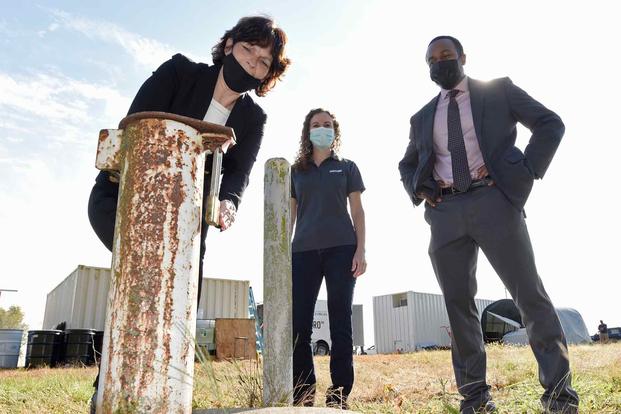The Pentagon has estimated that the cleanup costs for PFAS chemicals on active and former military bases, as well as in local communities, could exceed $31 billion, yet the Defense Department's budget for the job is falling behind, according to an advocacy group pressing for broader funding.
The Washington, D.C.-based Environmental Working Group issued a report Monday charging that, although the costs for cleaning up what are known as "forever chemicals" are soaring, the Pentagon consistently has requested just a fraction of the amount needed to remove these contaminants from the ground and groundwater at hundreds of sites.
In fact, the DoD has asked for less cleanup funding in recent years than it received in 2016, according to the group.
Read Next: Army Investigators Offer $25K Reward for Information on Slain Cadet
"The DoD is facing a ticking cleanup time bomb as funding falls dramatically behind cleanup costs," Jared Hayes, a senior policy analyst at EWG, said in a press release Monday. "It's clear that funding at current levels cannot possibly catch up to rising cleanup obligations."
PFAS chemicals are known as forever chemicals because they don't break down in the environment and can build up in the human body. They have been linked to certain types of cancer, thyroid disease, birth defects, low birth weight and decreased vaccine response in children.
The Defense Department estimated in 2021 that cleanup costs would run $31 billion. Since then, the Pentagon has requested more than a billion dollars each year to go toward cleanup. In fiscal 2023, the Pentagon requested $1.4 billion, which Congress increased to $2.2 billion.
For the fiscal 2024 budget, it has asked for $1.5 billion, up 7% from its fiscal 2023 request, but $700 million less than Congress provided for the year.
"We call the escalating backlog a cleanup time bomb because, based on current trajectories, DoD's cleanup challenge will become increasingly difficult if not impossible to overcome without substantial increases in funding," Hayes said in a briefing with reporters Monday.
The Defense Department has conducted assessments or is investigating the use of and contamination of per- and polyfluoroalkyl substances at 706 active and former military installations, National Guard facilities and other former defense sites.
As of last year, the DoD had completed the assessment phase at 476 installations, finding that at least 243 needed to proceed in the next step of the cleanup phase.
An additional 53 communities near an active or former installation also have been determined to have levels of two contaminants -- perfluorooctane sulfonate, or PFOS, and perfluorooctanoic acid, known as PFOA -- in their drinking water that is above the Environmental Protection Agency's 2016 accepted lifetime limits. The DoD is providing alternative water sources to those areas and developing cleanup plans to address the contamination.
The Pentagon announced earlier this year that it would stop buying firefighting foams containing PFAS by the end of the year and stop using them altogether by the end of 2024. While the military services have largely phased out the use of aqueous film forming foams containing PFAS, they still are used to fight fires on ships, submarines, aircraft hangars and firefighting operations, since an effective substitute has yet to be developed.
The Environmental Working Group recommended that Congress provide $2.75 billion in PFAS cleanup funding for fiscal 2024 -- $2 billion for active military sites and $750 million to clean up former military installations through the department's base closure funds.
"Remarkably, DoD is spending less on cleanups now than it did decades ago, even though new sites have been added to the cleanup load," said Scott Faber, EWG's senior vice president for government affairs, during the briefing. "We count on DoD for the security of our country, but protecting impacted defense communities, veterans and their families should be a top priority, not an afterthought."
-- Patricia Kime can be reached at Patricia.Kime@military.com. Follow her on Twitter @patriciakime.
Related: Lejeune Water Link to Parkinson's Disease Affirmed in New Larger Study











